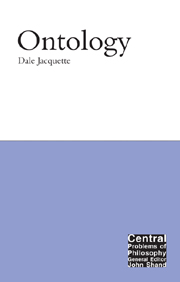Book contents
- Frontmatter
- Contents
- Preface
- Acknowledgements
- Introduction: Being as such
- I Pure philosophical ontology
- II Applied ontology and the metaphysics of science
- 6 Ontological commitment (on Quine)
- 7 Appearance, reality, substance, transcendence
- 8 Physical entities: space, time, matter and causation, physical states of affairs and events, natural laws
- 9 Abstract entities, particular and universal: numbers, sets, properties, qualities, relations, propositions and possibilities, logical, mathematical and metaphysical laws
- 10 Subjectivity of mind in the world of objective physical facts
- 11 God, a divine supernatural mind?
- 12 Ontology of culture: language, art and artefacts
- Conclusion: scientific–philosophical ontology
- Notes
- Bibliography
- Index
9 - Abstract entities, particular and universal: numbers, sets, properties, qualities, relations, propositions and possibilities, logical, mathematical and metaphysical laws
from II - Applied ontology and the metaphysics of science
- Frontmatter
- Contents
- Preface
- Acknowledgements
- Introduction: Being as such
- I Pure philosophical ontology
- II Applied ontology and the metaphysics of science
- 6 Ontological commitment (on Quine)
- 7 Appearance, reality, substance, transcendence
- 8 Physical entities: space, time, matter and causation, physical states of affairs and events, natural laws
- 9 Abstract entities, particular and universal: numbers, sets, properties, qualities, relations, propositions and possibilities, logical, mathematical and metaphysical laws
- 10 Subjectivity of mind in the world of objective physical facts
- 11 God, a divine supernatural mind?
- 12 Ontology of culture: language, art and artefacts
- Conclusion: scientific–philosophical ontology
- Notes
- Bibliography
- Index
Summary
Abstract entities
More ink has been spilled on the question of the existence of abstract entities than on any other topic in ontology. Do universals exist? What about sets and numbers, properties, qualities, relations, propositions and laws? What light can we shed on these controversies from the standpoint of a combinatorial analysis of being?
We have already touched on several categories of abstract entities. Looking forward to what might be said or what others have said about non-spatiotemporal particulars and universals, we have provisionally considered the possibility of their existence. We must now put our cards on the table and examine whether in fact there are abstract entities, whether abstract non-spatiotemporal things in addition to physical spatiotemporal things exist, and whether or not abstract entities should be included in the extant or preferred theoretical existence domain.
The fact that the combinatorial analysis provides a definition of what it means for something to exist gives us an important advantage over most of the history of metaphysics in which the ontic status of abstract entities has been debated. Without a clear-cut positive concept of being, applied scientific ontology can only fumble in the dark, relying on Ockham's razor to determine whether or not a purported unperceivable entity exists according to perceived minimal explanatory needs. As we noted in our critique of Quine's criterion of ontological commitment, Ockham's razor is an uncertain basis for deciding what actually exists.
- Type
- Chapter
- Information
- Ontology , pp. 206 - 232Publisher: Acumen PublishingPrint publication year: 2002



